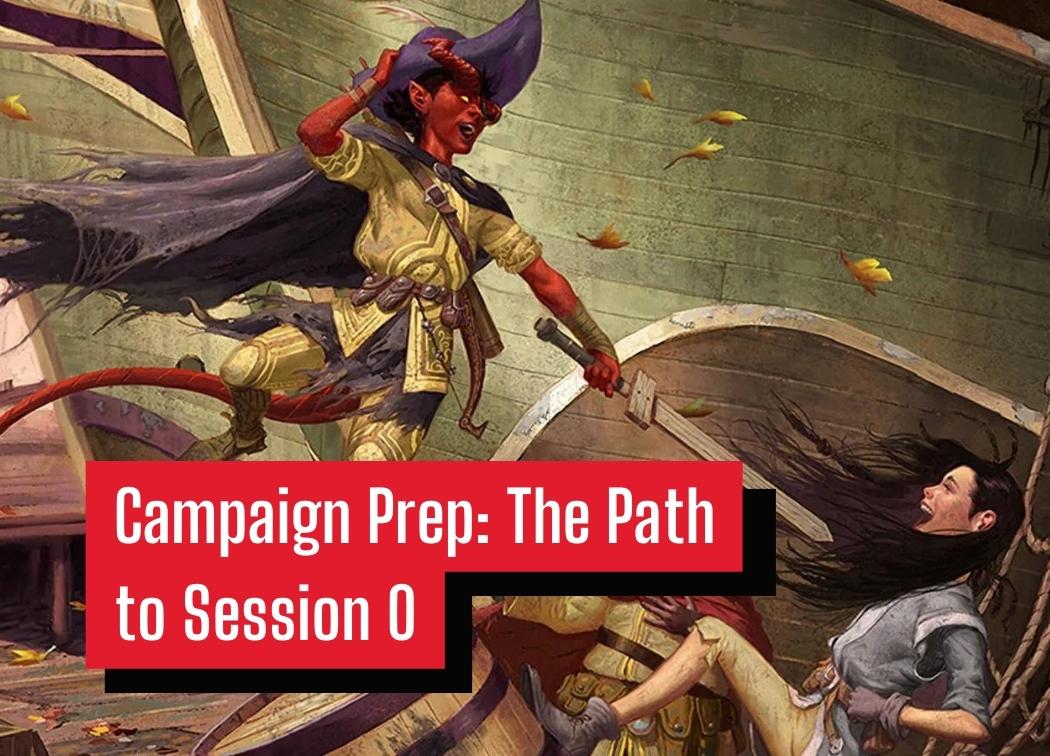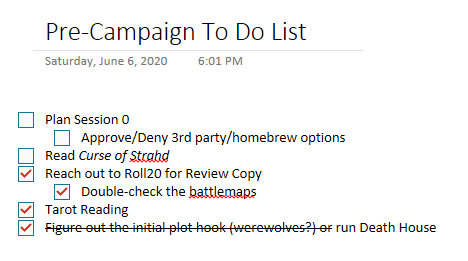Campaign Prep: The Path to Session 0

A while ago I thought I was close to the end of my 3+ year D&D campaign. We wound up playing for another four months, but it did eventually come to a satisfying close. We had the big boss battle, the satisfying conclusion, and each character’s epilogue. It was great.
I was itching to close it out. Not because it was a bad campaign, it was the best one I’ve run. I just wanted something new to dive into.
We’re currently holding out on starting until peoples’ work schedules go back to normal hopefully in the fall… I’m not holding my breath. However, this has given me plenty of time to plan and prep the campaign.
I realized that this is an opportunity to show how I prep a long-term D&D campaign here on the site. Hopefully, this will be useful info for newcomers to the hobby on how to get started and may showcase a different perspective and new techniques for more seasoned veterans of D&D.
So every so often when I hit a milestone in my campaign prep I’ll write up what I did and why I did it. Today we’re going to be talking about what I call pre-session 0 prep. Stuff that I like to have done before sitting down with the players and talking about their characters and the finer details of the game.

Choose Your Adventure
I’ve talked about running a hardcover adventure for some time. My group did play through a bit of Out of the Abyss in college but we graduated before we got too deep into it. It was a fun time for sure and a nice departure from creating a whole homebrew campaign like I always do. However, I wanted to try running one cover to cover.
So the first step was to figure out what kind of adventure we’d want to do. I gave the group a few options:
- Hardcover Adventure
- Homebrew Sequel Adventure
- Featured one of the characters’ epilogues that meshed well with a new campaign tie-in.
- Other Homebrew
- Asked for their ideas/input
Some feedback I got from the last campaign asked for the next campaign we do to include a lot more roleplaying. It’s one of my weaker points as a DM so it’s a fair criticism and something I want to work on anyway. This also ruled out Dungeon of the Mad Mage immediately.
The players didn’t want the sequel adventure either since we have a couple of new players joining the group. Also fair.
The response was overwhelmingly in favor of Curse of Strahd. It has a bit of something for everyone and most of them had already heard of it due to its high praise as the best-written adventure of 5e. Plus I have a few gothic horror fans in the group.
So I grabbed a physical copy of the book and the folks at Roll20gave me a copy of the campaign for all of those sweet, sweet battlemaps and got to work!
Campaign Rules
Now that I had a starting point my next task was to lay down some rules for the game. Most of my rules came from feedback gathered from various one-shots and campaigns I’ve run over the years.
The first of which was that character creation would be done using point buy. It solves so many issues with 5e character creation compared to rolling it’s wild. For example, feats are way more valuable because you don’t have people starting with 18+ in stats. Choosing a feat is a big deal. Plus, everyone starts on equal footing making game balance much easier.
I also threw out the idea of fleshing-out my “initial ASIs are tied to classes” idea. Everyone was willing to try it but I’m sort of on the fence now. We’ll see.
Some feedback I gathered in my previous campaign was that they wanted fewer homebrew character options. This feedback came from the players playing homebrew races/classes/subclasses citing that some of their shit got/felt super imbalanced as they leveled up.
So given that I’m limiting everyone to choose from the PHB and XGtE. I’ll allow other WotC products and releases on a case-by-case basis.
It’s not that everything WotC makes is balanced. It’s not. However, it’d be nice to experience a vanilla-ish style campaign while playing a hardcover adventure.
Organize Your Notes
Before purchasing Curse of Strahd, I started organizing my notes. For my previous campaign, I used separate word docs filed into different folders that were filed under different folders. It was a mess.
However, I learned during my Shadow of the Demon Lord campaign prep that Microsoft OneNote was a solid resource for campaign management. I’m going that route again for my Curse of Strahd campaign. Take a look at the article on the subject for more information/inspiration.
There are a plethora of resources and programs you can use to keep track of your notes. Hell, even a notebook will do. Start organizing your thoughts and notes ASAP so that your notes don’t become an entangled web of noise you have to sift through mid-session.
Trust me, even if you keep your notes well-organized you’ll still run into issues. Though these issues will be far less frequent if you’ve done your due diligence.
Make a To-Do List
Any type of event planning requires multiple tasks and subtasks to complete. A D&D campaign is no different.
I find for me I work best when I lay out everything that I need to do for each phase of campaign planning. That way I know what each step should be and what’s still left to be done. Plus, checking off an item is its own little reward!

I’ve included my current to-do list in the screenshot above. I’m also realizing now that I forgot the hyphen between to-do, which brings me to my next point. Your list isn’t set-in-stone once you make it!
As you progress through your planning you’ll add additional tasks and subtasks. For example, I didn’t have “Tarot Reading” on there until I started reading Curse of Strahd. I didn’t even know that I’d have to perform that at all.
Side note, it’s a cool and flavorful addition to the adventure to spice the conclusion up quite a bit.
If Applicable: Read the Materials
If your next campaign is premade (third-party or official) like mine is the first step should be to read the materials. You don’t need to memorize everything if you don’t want to, but a fully fleshed-out idea of what’s (possibly) in store for the party before you begin is valuable.
There’s a solid chance your group will miss plenty of content from the adventure you run. However, having that background allows you to anticipate what might come next each session. This will save you time since rather than reading whole chapters and adventures as you go, you can skim the contents of the relevant sections, saving you prep time as you go.
You’re spending time now to save a lot of time later. Time that you can use to customize the adventure if need be to weave in the party’s backstories or unique decisions that weren’t anticipated by the writers and designers.
Keep a List of Items to Bring Up During Session 0
As you read through the book you should keep track of important items that you should bring up during session 0. This could include, but is not limited to the following:
- Useful information for the players prior to character creation.
- E.g. do the dungeons assume the party has someone with proficiency in Thieves’ Tools?
- An overview of the adventure to give the party a brief insight of what the story is about.
- E.g. Curse of Strahd is a gothic horror campaign centered around defeating an evil vampire lord in his domain. You’ll need to make valuable allies and become stronger in this depressing and decrepid land to do so.
- Potentially uncomfortable subjects.
- E.g. If you know an adventure has a lot of spiders in it and you have an arachnophobic in the group. Bring that up at or before Session 0.
- An adventure like Curse of Strahd has things like body horror and torture engrained in it. Some people don’t mind the mention of these subjects but they might be averse to hearing vivid descriptions of it.
All of these aspects are important, but I’d like to drill home that it’s important to make sure everyone is having fun in your game. If someone speaks up to you during session 0, privately, or anytime during the campaign regarding being uncomfortable with a theme, description, etc. do your due diligence to change the adventure to accommodate them.
Also if there’s something you find uncomfortable don’t be afraid to change it.
Games are more fun when everyone is having fun!
Identify Any Weak Points
Not every adventure is equal in terms of quality. Some adventures may have an awesome premise and fun dungeons & quests, but they might not tie everything together in a logical way. Unfortunately, this means you need to do some extra legwork as you prep.
Make note of these areas and flaws. If you can fix them while doing your initial read-through, great! However, you may also need to fix them as the party progresses through the adventure. Their choices may impact how they arrive at these gaps so you need to be wary of that.
A weak point can also be subjective. Something could work just fine as written but you dislike how it plays out or reads. Maybe you know it won’t engage your players like it would a normal group. Change it!
Consider the Starting Point
The adventure you’re running may have a predefined starting point or like Curse of Strahd it may have a plethora of ways to start the adventure. The book includes a ton of different adventure hooks to explain why the party is in the situation they’re in.
However, it also includes Death House, a free adventure that will bring level 1 characters to the appropriate starting point of level 3. We opted to run Death House but it was nice to give the group the option of starting at a higher level if they wished to skip level 1.
This is probably the easiest part of making a homebrew campaign. You can make the starting level anything since you’re building the campaign from the ground up.
Conclusions
So there’s where I’m at for my pre-session 0 planning! I still need to finish the book as I only got about 2/3 of the way through it during my vacation, but I anticipate holding our session 0 within the next month or so and hopefully starting it soon after. Although unfortunately, our start date relies on factors outside of our control.
Well, no it is within our control. Be smart, wear a fucking mask and vote for people who will bring positive change to your community.
I hope this sneak-peek into my thoughts and process on campaign planning helped a bit. There’s no one-size-fits-all for campaign planning, but I believe a lot of what I do here is covered in one way or another by most DMs. Even if the process is different.
Be sure to let me know if there are other aspects or topics you’d like me to cover throughout this sporadic series!
